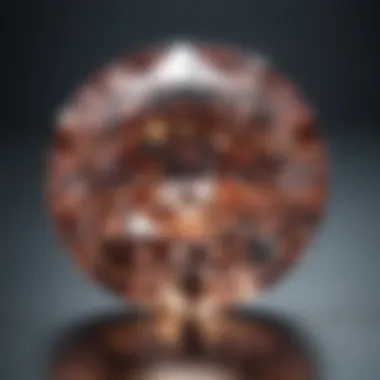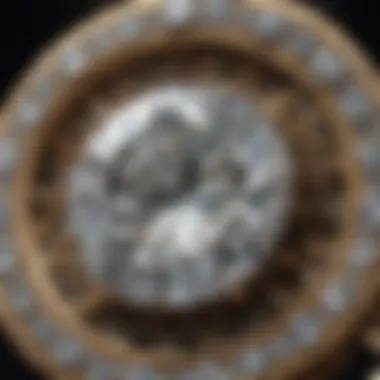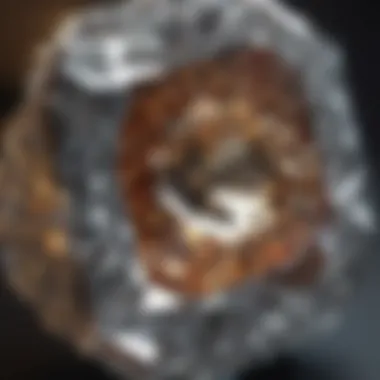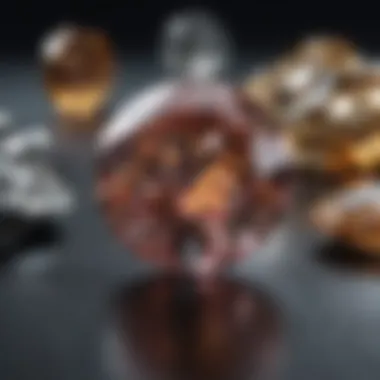Understanding Mine Cut Diamonds: Key Features & Value


Intro
This article focuses on mine cut diamonds, providing a detailed exploration of their unique characteristics and significance in the jewelry market. By delving into the rich history, distinctive features, and cutting techniques involved in producing these gemstones, we aim to offer an expansive view of their value and appeal to collectors and consumers.
Gemstone Overview
Definition of Gemstones
Gemstones are precious or semi-precious minerals that are cut, polished, and used in jewelry and decorative items. They possess beauty, durability, and rarity, which combine to enhance their value.
Classification of Gemstones
Gemstones can be categorized into various classes based on their properties. They can be divided into:
- Precious Gemstones: Diamonds, rubies, sapphires, and emeralds are commonly referred to as precious gemstones.
- Semi-Precious Gemstones: This category includes a broader range of stones such as amethyst, aquamarine, and garnet.
- Organic Gemstones: Pearls and amber are notable examples, originating from living organisms, differing from typical mineral-based gemstones.
Historical Significance
Origins of Gemstone Use
The use of gemstones can be traced back thousands of years. Ancient civilizations valued gemstones for both aesthetic and symbolic reasons. This pattern continues today but with more advanced cutting methods and higher market demand.
Cultural Insights: Gemstones in Ancient Civilizations
In ancient Egypt, gemstones were used in jewelry as well as for burial artifacts. They believed these stones held protective properties. In contrast, ancient Romans viewed gemstones as a status symbol, seeking the rarest stones to signify wealth and power.
"Mine cut diamonds, with their unique characteristics, reflect the craftsmanship and cultural significance of gemstone use through history."
With the evolution of time and techniques, the mine cut diamond emerged, carrying rich historical value while also becoming a sought-after item in modern jewelry design. Understanding these diamonds means appreciating the journey of craftsmanship involved in their creation.
Preamble to Mine Cut Diamonds
Understanding mine cut diamonds involves delving into their distinctive characteristics and the historical relevance they carry. This section serves as an essential foundation, highlighting what sets these diamonds apart from modern cuts. Mine cut diamonds often carry a narrative that resonates with collectors, designers, and enthusiasts alike. The craftsmanship involved in their creation reflects a time when diamonds were not just gemstones but works of art.
Definition of Mine Cut Diamonds
Mine cut diamonds refer to a specific style of diamond cutting that was prevalent during the 19th century. Unlike modern diamond cuts that focus on maximizing brilliance and light performance, mine cut diamonds possess a more traditional aesthetic. Typically, they feature a rounded outline and a depth that contributes to their unique charm. The number of facets also varies, but mine cut diamonds generally have fewer facets compared to the advanced cuts we see today, such as the brilliant cut. This results in a different light reflection quality, giving them a distinct character often described as warm and inviting.
Historical Context
The history of mine cut diamonds is deeply intertwined with the evolution of diamond mining and jewelry making. During the 1700s and 1800s, diamonds were sourced primarily from alluvial deposits. As mining technology improved, larger diamonds became available, leading to the development of this cutting style. Mine cut diamonds were often fashioned by hand, which required exceptional skill and knowledge from the artisans. The popularity of mine cuts peaked in the Victorian era and continued into the Edwardian period, serving as a significant expression of elegance and status. Today, these diamonds embody not only beauty but also a historical legacy that appeals to collectors and those with an appreciation for vintage jewelry.


"Mine cut diamonds are a bridge to the past, showcasing artistry and craftsmanship that modern cuts sometimes overlook."
In summary, mine cut diamonds represent a fascinating blend of history and craftsmanship. Understanding their definition and historical context allows for a deeper appreciation of their significance in both the jewelry market and the broader cultural narrative of gemstone use.
The Unique Characteristics of Mine Cut Diamonds
Mine cut diamonds possess several unique characteristics that set them apart from modern cuts. These features influence their aesthetic appeal and collectible value. Understanding these elements is essential for gem enthusiasts and collectors. The distinctive qualities reflect the diamond's historical significance and the craftsmanship of the time.
Cutting Techniques
The cutting techniques used for mine cut diamonds differ substantially from those employed in contemporary diamond cutting. Mine cut diamonds, popular in the late 19th and early 20th centuries, were crafted by hand. Artisans would manually shape the stone, focusing on maximizing its natural beauty rather than adhering to the precise proportions seen in today's cuts.
One prominent technique was the method of "table cutting," which involved creating a flat surface on the top. This approach allowed the diamond to reflect light effectively, albeit in a different way than modern methods. Techniques emphasized the unique features rather than geometric perfection. The tools were rudimentary compared to those found today, which also influenced the overall style of the final product. As a result, each mine cut diamond is distinct, often exhibiting irregularities that tell a story.
Shape and Proportions
The shape and proportions of mine cut diamonds typically reveal the unique cutting methods of their era. The most common shapes include cushion and old mine cuts, both of which showcase rounded corners and larger facets. These shapes tend to have a softer appearance compared to the sharper, more angular shapes found in modern cuts such as the round brilliant.
In general, mine cut diamonds are less uniform than their modern counterparts. For instance, the proportions can vary significantly, affecting how each diamond interacts with light. As a result, these diamonds have subdued brilliance compared to contemporary cuts. However, their charm lies in their uniqueness and the richness of their character. Collectors appreciate these nuances, understanding they represent a different era in jewelry making.
Quality of Light Reflection
The quality of light reflection in mine cut diamonds varies significantly from modern cuts. While modern diamonds focus heavily on optimal light return, mine cut diamonds offer a different kind of allure. The large, open facets create a softer glow rather than an intense sparkle. This feature, often described as a warmth to the light, is characteristic of mine cut diamonds.
This reflection quality is a result of the earlier cutting techniques and proportions. While it can lead to lower brilliance, many find it gives these diamonds an enchanting quality that seems to enhance their individuality. Collectors often seek these unique light properties, as they reflect the diamond's history and craftsmanship.
The beauty in mine cut diamonds lies not only in their physical attributes but also in their story, representing a rich textile of artistry and history.
Comparing Mine Cut Diamonds to Modern Cuts
When exploring the realm of diamonds, understanding the comparison between mine cut diamonds and modern cuts is essential. Each type boasts its unique advantages, appealing to different tastes and preferences. This section aims to delve into the distinctions, market perceptions, and the implications for resale and collectibility that define mine cut diamonds in contrast to their modern counterparts.
Differences in Style
Mine cut diamonds, often characterized by their chunky, less uniform shapes, possess a vintage charm that starkly contrasts with the sleek, symmetrical design of modern cuts such as the Round Brilliant. Mine cuts, also known as Old Mine Cuts, feature a cushion-like appearance with rounded corners and less precise facets. This results in a softer glimmer, which some find more appealing than the brilliant sparkle of modern cuts. The way light interacts with these diamonds gives them their own unique character.
Modern cuts often prioritize mathematical precision and maximize the brilliance of light reflection. They are crafted with an intention to achieve specific optical properties, often leading to superior sparkle. The distinction in style reveals the subjective nature of beauty in gemstones, where personal taste plays a crucial role in the choice between these two types.
Market Perception
The market perception of mine cut diamonds reflects both nostalgia and sophistication. With the rise of vintage jewelry, many consumers now seek out mine cut diamonds for their historical significance and unique aesthetics. These diamonds are regarded not only as gemstones but as pieces of art and history, embodying a craftsmanship that is often seen as superior to mass-produced modern cuts.
In recent years, there has been a noticeable shift as more jewelry designers incorporate mine cut diamonds into contemporary designs. Jewelers like Brilliant Earth and Oscar Heyman showcase these stones, attracting enthusiasts who appreciate their distinctiveness. Moreover, the market for antique jewelry is also expanding, with mine cut diamonds gaining recognition among collectors, further enhancing their allure.


Resale Value and Collectability
The resale value of mine cut diamonds can vary significantly compared to modern cuts. Factors influencing this variation include market demand, historical significance, and aesthetic appeal. Collectors often pay a premium for these diamonds, valuing the rarity and unique characteristics that modern cuts may not replicate.
- Collectability: Mine cut diamonds are increasingly sought after for their individuality, leading to a growing community of collectors who appreciate their rarity. This trend has implications for resale value.
- Investment Potential: Often, they do not depreciate as quickly as some modern diamonds, retaining or even increasing their value over time.
"Investing in mine cut diamonds is not just about the stone. It is about owning a piece of history that carries its aesthetic and intrinsic values."
Caring for Mine Cut Diamonds
Caring for mine cut diamonds is an essential aspect of ownership. These stones, with their unique historical context and distinctive characteristics, deserve proper maintenance to preserve their beauty and value over time. Understanding the care involved can elevate the experience of owning such a remarkable piece of jewelry. This section delves into practical strategies and considerations for maintaining your mine cut diamonds effectively.
Cleaning and Maintenance
Regular cleaning and maintenance are crucial for keeping mine cut diamonds looking their best. Dust, oils, and dirt can accumulate, diminishing their shine. Here are some proven techniques for cleaning:
- Use Mild Soap and Water: Mix a small amount of mild dish soap with warm water. Soak the diamond in this solution for about 20 minutes.
- Soft Brush Application: After soaking, gently scrub the diamond using a soft-bristled toothbrush, particularly around the base where dirt might linger.
- Rinse Thoroughly: Rinse the diamond under lukewarm water to remove any soap residue. Ensure you cover the sink's drain to prevent losing the diamond.
- Drying with Care: Use a lint-free cloth to pat the diamond dry. Never use paper towels, as they can scratch the surface.
It is advisable to clean these diamonds every few weeks or immediately after wearing them, especially if you have applied lotions or perfumes. For deeper cleaning, professional services are available, which can provide ultrasonic cleaning that effectively removes any remaining deposits without damaging the diamond.
Storage Recommendations
Storing mine cut diamonds correctly is crucial to avoid scratches and other damage. Here are some recommendations:
- Separate Compartment Storage: Always keep each diamond in its compartment within a jewelry box. This prevents them from coming into contact with other gemstones or jewelry that might scratch their surface.
- Use Soft Pouches: For added protection, use soft cloth pouches for each piece when not in use. This can provide an extra layer of security against accidental scratches.
- Avoid Humidity: Store the diamonds in a climate-controlled environment. Excessive moisture can lead to problems such as tarnishing of metal settings.
- Regular Checks: Periodically inspect your pieces for any signs of wear or loosening of settings. Prompt repairs can help maintain the integrity of the diamond.
Utilizing these cleaning and storage techniques will ensure that your mine cut diamonds maintain their luster and value, reflecting the craftsmanship and beauty associated with this unique cut.
The Investment Potential of Mine Cut Diamonds
Mine cut diamonds represent a unique segment of the diamond market, characterized by their historical significance and distinct designs. As interest in vintage and antique jewelry grows, their investment potential is increasingly coming into focus. Investing in mine cut diamonds can offer several benefits, including aesthetic appeal and potential for long-term value appreciation. However, there are also considerations which must be carefully pondered before making such investments.
Achieving understanding of how mine cut diamonds fit into the broader market landscape can guide potential investors.
Market Trends and Insights
Market trends indicate a steady rise in demand for vintage jewelry, with mine cut diamonds at the forefront. They appeal to buyers who value their rich history and craftsmanship. Many collectors are willing to pay a premium for these diamonds, contributing to a niche market that can see significant price appreciation over time.
- The authenticity and rarity of mine cut diamonds boost their desirability.
- Collectors appreciate the stories behind these stones, which can enhance perceived value.
Recent auction sales illustrate this trend. Mine cut diamonds often fetch prices well above their estimated values. This can be attributed to their unique characteristics as well as an increase in awareness and appreciation for antique diamonds in contemporary markets.


Factors Influencing Value
The value of mine cut diamonds can be influenced by various factors, such as:
- Carat Weight: Larger stones generally have higher value, but the uniqueness can sometimes offset smaller sizes.
- Color and Clarity: As with all diamonds, higher clarity and better color grades usually command greater prices.
- Provenance: A diamond's history and previous ownership can significantly impact value. Stones with notable past owners or stories often attract collectors.
- Craftsmanship: The quality of the cut and overall design contribute to desirability. Mine cuts are distinctively different from modern cuts, and this uniqueness adds to their appeal.
- Market Demand: Trends in the market, including fashion influences and consumer sentiments towards vintage items, can drive demand and fluctuate prices accordingly.
Understanding these factors is crucial for any investor looking to enter the mine cut diamond market. The uniqueness of each stone, combined with the growing interest in historic jewelry, presents a compelling case for their potential as an investment.
Mine Cut Diamonds in Contemporary Jewelry
Mine cut diamonds are reclaiming their position in the jewelry market as more consumers seek unique and authentic designs. Their historical significance, combined with distinctive features, makes mine cut diamonds a compelling choice for both jewelry designers and buyers today. The resurgence of interest reflects a broader trend toward appreciating vintage styles and craftsmanship, as well as a desire for individuality in personal adornment.
Current Design Trends
In contemporary jewelry design, mine cut diamonds are increasingly featured in various collections. This reflects a growing inclination toward unique aesthetics in a world often dominated by modern, highly refined cutting techniques. These diamonds often find a place in custom pieces, where their broader facets and irregularities lend originality to rings, necklaces, and earrings. Their ability to reflect light in a less uniform yet enchanting manner contributes to a design trend that seeks to break away from the perfection characterized by modern cuts.
Some popular trends include:
- Artisan designs: Jewelers are crafting pieces that display the character of each mine cut diamond. The finished pieces often highlight the stone's individuality rather than disguising it.
- Eclectic styles: Mine cut diamonds are often mixed with colored gemstones or uncut diamonds, leading to distinctive compositions that stand apart from standard jewelry.
- Vintage revivals: As collectors and enthusiasts appreciate the charm of historical styles, designs that invoke past eras have gained popularity. Mine cut diamonds are ideal for recapturing the essence of heirloom pieces from the 19th and early 20th centuries.
Popular Settings for Mine Cut Diamonds
The unique geometry and artisanal quality of mine cut diamonds influence the settings utilized in their presentation. Jewelry designers choose settings that enhance these stones rather than overshadowing them.
Traditional prong settings are commonly employed but can be modified to create more elaborate designs that maintain the stone's visual appeal. Here are several popular settings:
- Bezel settings: These encase the diamond, providing protection while highlighting its shape. This setting style allows the diamond's characteristics to stand out.
- Cluster settings: Using multiple mine cut diamonds together creates a dazzling effect. This appeals to those who wish for added brilliance and dimension in their jewelry.
- Halo settings: Positioning smaller diamonds around a mine cut diamond enhances its allure, making the centerpiece appear larger and more radiant.
Mine cut diamonds are valued for their distinctive charm and capacities to blend effortlessly into modern jewelry aesthetics. Their unmatched beauty and historical context make them sought-after items for jewelry enthusiasts.
In summary, mine cut diamonds are redefining the landscape of contemporary jewelry design. Their engaging design possibilities and the sentimental value attributed to their history contribute to their enduring appeal. As consumers embrace individuality and artistry in jewelry, mine cut diamonds will likely continue their resurgence in the market.
Epilogue: The Relevance of Mine Cut Diamonds Today
Mine cut diamonds hold a unique position in the landscape of gemstones. Their historical significance, combined with distinct characteristics, makes them appealing to a niche market of collectors and jewelry designers. The relevance of mine cut diamonds today stems from a few key aspects: their rich history, aesthetic qualities, and investment potential.
Enduring Appeal
The allure of mine cut diamonds is rooted in their history and craftsmanship. Unlike modern cuts, mine cut diamonds reflect a simpler, yet profound approach to diamond cutting that emphasizes the stone's natural beauty. This vintage charm resonates with individuals who appreciate the artistry of earlier cutting techniques.
Their irregular shapes and unique facets create a one-of-a-kind sparkle. Many jewelry enthusiasts are drawn to mine cut diamonds not only for their rarity but also for the stories they carry. Every diamond encapsulates an era where each cut was a labor-intensive process, thus adding sentimental value.
"Mine cut diamonds invite contemplation. They are not just stones; they are windows to the past."
Today, mine cut diamonds are being incorporated into contemporary designs, highlighting their versatility. Designers often blend these diamonds with modern aesthetics, creating jewelry that appeals to both traditional and modern tastes. This fusion keeps the appeal of mine cut diamonds alive, ensuring they remain relevant in a rapidly evolving market.
Final Thoughts
As we reflect on the relevance of mine cut diamonds today, it is essential to recognize their significance beyond mere aesthetics. Their value extends into the realms of history, craftsmanship, and investment. While trends in jewelry change, the enduring charm of mine cut diamonds suggests they will continue to captivate the interest of collectors and enthusiasts alike.
In a world increasingly focused on mass-produced items, mine cut diamonds provide an authentic alternative. They represent a commitment to quality that many desire in their jewelry. Thus, investing in these diamonds is not just about acquiring a gem; it's about preserving a piece of history and showcasing individuality.



